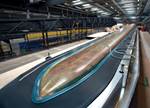Wind economics by the numbers
The upsurge in wind-energy growth is surprising only to those who cannot look at the industry in its wider economic context.
The upsurge in wind-energy growth is surprising only to those who cannot look at the industry in its wider economic context. During the past five years, the price of electricity from fossil fuels (oil, natural gas and coal) increased from $1.54/million Btu in 2005 to $2.22/million Btu as of January 2010. It was within this window that the price of oil also rode its roller coaster from about $50/barrel in 2005, to $140/barrel in mid-2008, down to about $75/barrel as of this writing, (the drop largely the result of a recession-inspired reduction in oil consumption). This net $25/barrel cost increase, combined with the uncertainty bred by oil’s volatility, reduced the relative cost of wind energy and made it a more viable source of electricity. On top of that, the U.S. government’s annually renewable production tax credit (PTC) for manufacturers of renewable energy systems — including wind turbine makers — has been the impetus for much of wind energy’s growth in the U.S. over the last several years. In 2009, Congress renewed the PTC for a multiple-year run, removing the uncertainties during previous years, while developers awaited a renewal decision. This provides a 2.1¢/kWh benefit for the first 10 years of a renewable-energy facility’s operation. All of these factors combined to give birth to the earnest appeal of — and, ultimately, the Obama Administration’s official U.S. stamp of approval on — renewable-energy resources.
It wasn’t always so. During the time periods that predated the volatility of fossil fuel prices, wind energy in the U.S. was a cottage industry — it was relatively small and growing steadily, but not cost-competitive with oil, gas or coal. The number of wind turbines manufactured and installed in the U.S. was modest, yet was showing steady growth: In 1999, installed wind-energy capacity was 2,472 MW. By 2005, it was 9,147 MW. Then, the U.S. climbed aboard the energy roller coaster for a lengthy ride. The result was a series of dramatic increases in U.S. installed wind-energy capacity: 11,575 MW, 16,907 MW, 25,410 MW and 34,863 MW, during the years 2006 through 2009, respectively.
Related Content
-
Trends fueling the composites recycling movement
Various recycling methods are being considered for composites, from novel dismantling and processing, to building capacity and demonstrating secondary use applications.
-
We4Ce infused 2.5-3-MW rotor blade design passes validation test
Composite rotor blade structure design by We4Ce, mold and prototype production by InDutch Composites and fatigue testing by Suzlon Group has resulted in the novel blade’s IEC61400-5:2020 certification.
-
High-tension, vertical filament winding enables affordable flywheel energy storage system
French startup Energiestro’s prototype solar energy flywheel-based storage system aims to reduce costs with glass fiber composites and prestressed concrete.



